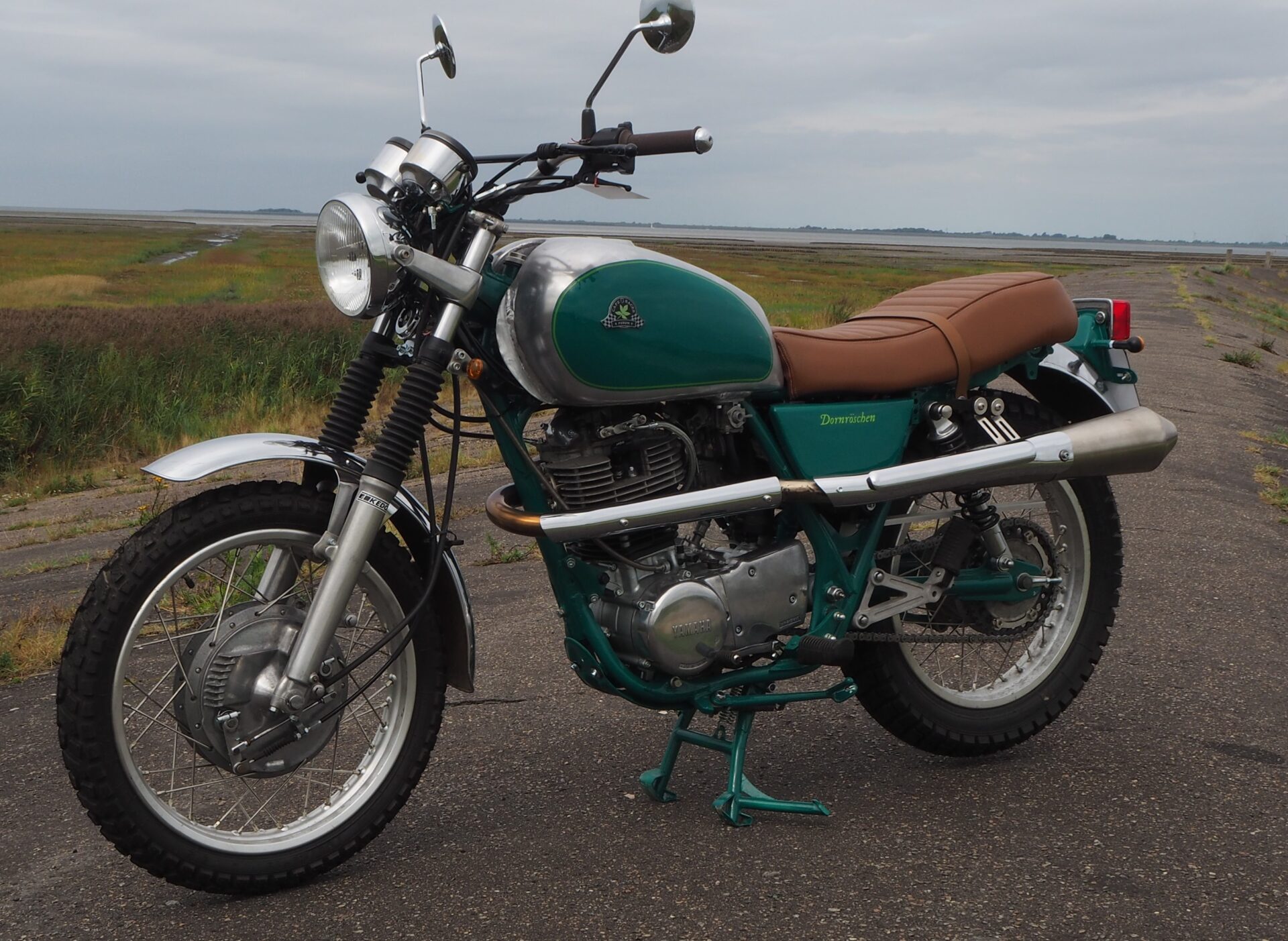
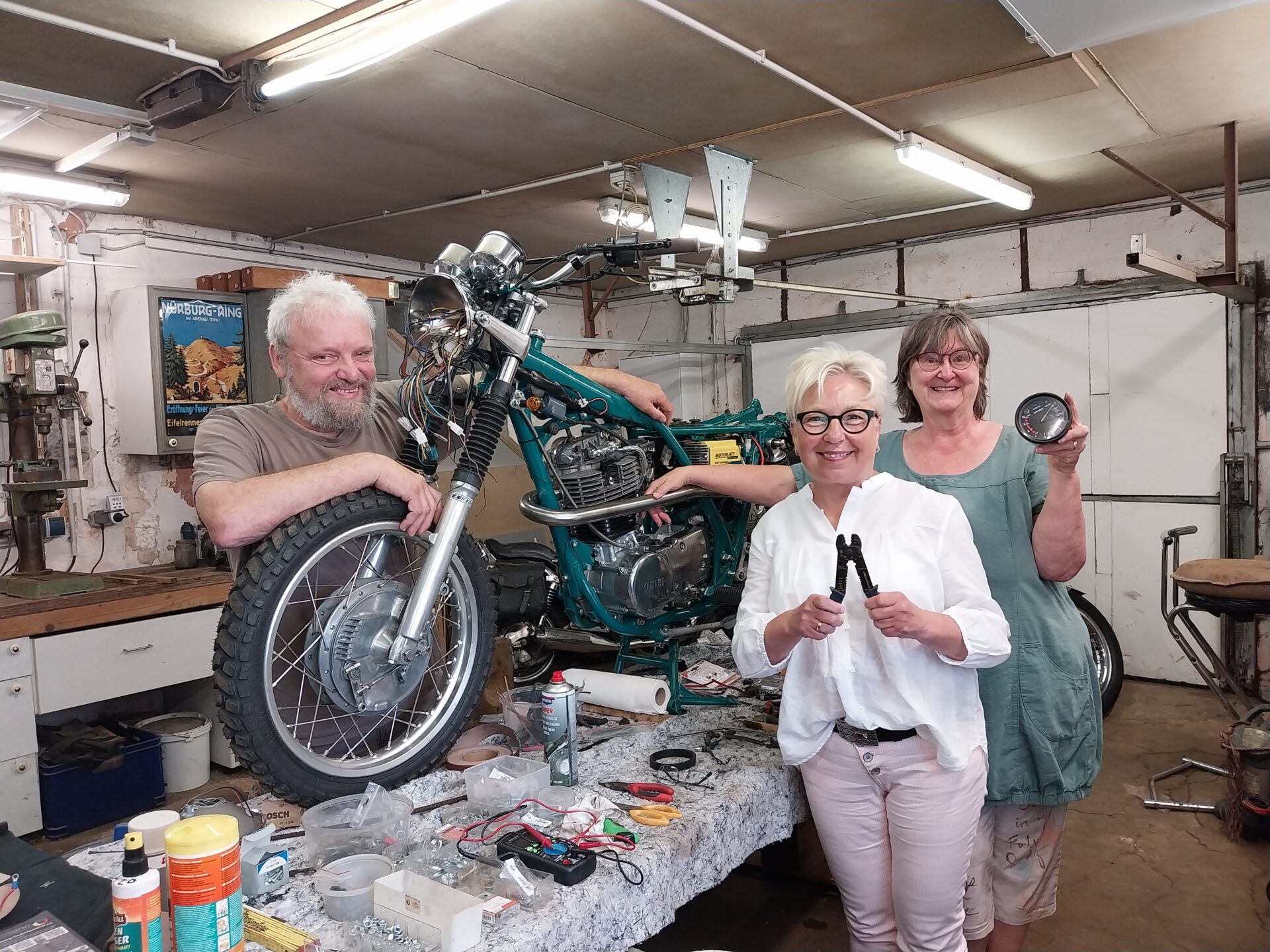
In the picture: Martin Terrey next to Dagmar Ströhle-Jensen and Ulrike Terrey from Hospizdienst Eiderstedt
A barn find would certainly have been less corroded. Now we had to do what had to be done. Dismantle. Clean. Paint, polish or replace and dispose of.
Every move is doubly worthwhile here. After completion, an official custom bike will be available for auction.
Already at the KEDO Kick-off 2025 With your help, we raised an impressive 1000 euros in donations for the project.
The total proceeds from the auction of the Sleeping Beauty will be donated to the Eiderstedt Hospice Service.
A colossally good cause that KEDO is happy to support.
She was dropped ages ago and is still a top candidate.
The best years are long gone. Back then, Falco was still in the charts. Now it was high time to breathe new life into the good SR500T. A new purpose is on the cards. If many add-on parts are irretrievably lost, it is worth thinking about an official makeover.
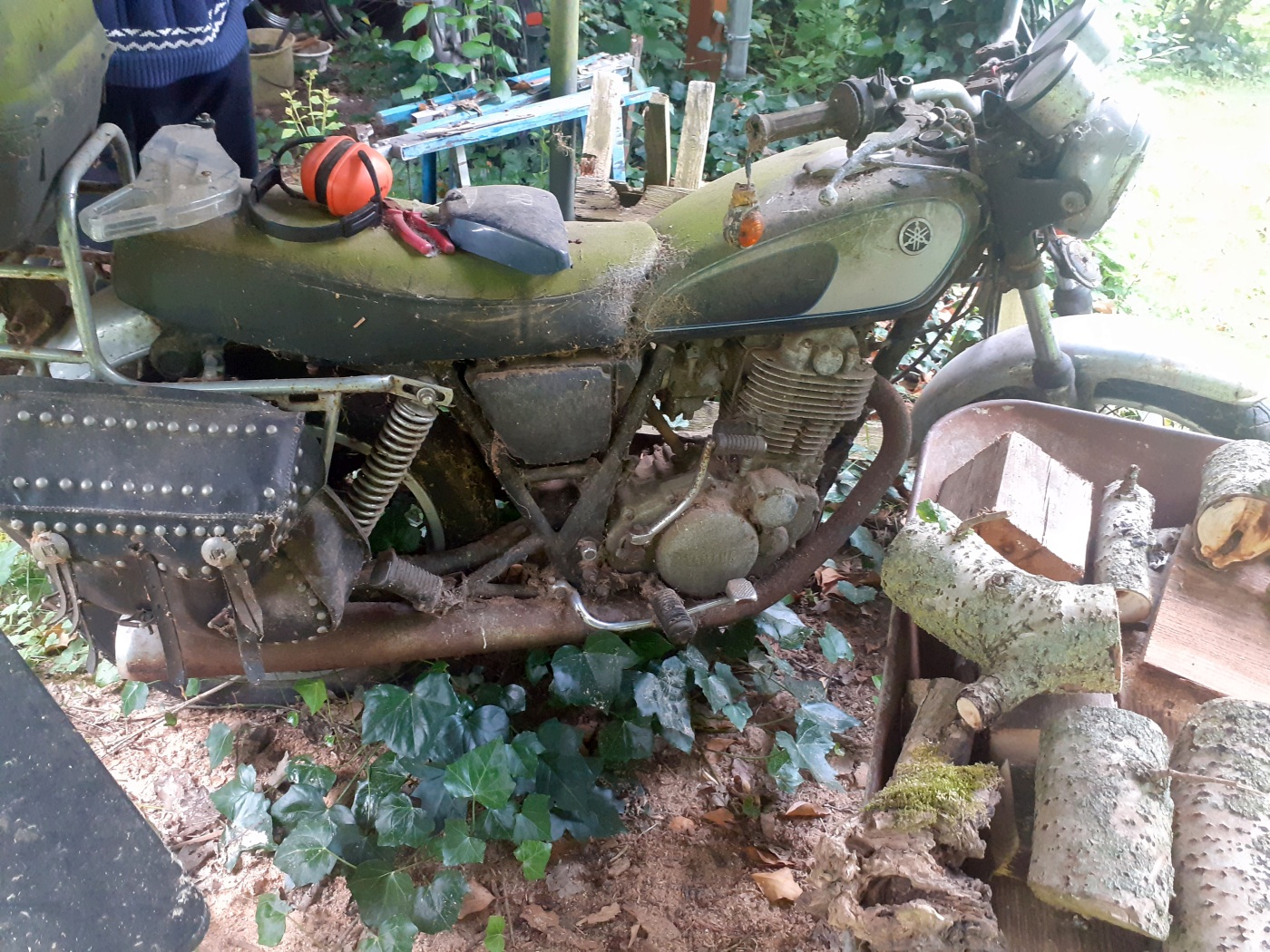

Beneath the battered surface lies a treasure. KEDO ensures that every minute of refurbishment is worthwhile with a well-stocked web store and almost 35 years of experience. Go for it, we have the parts.
Once the first engine parts have been refurbished, this boosts your motivation immensely. From now on, there's no going back. Imagination has a GO.
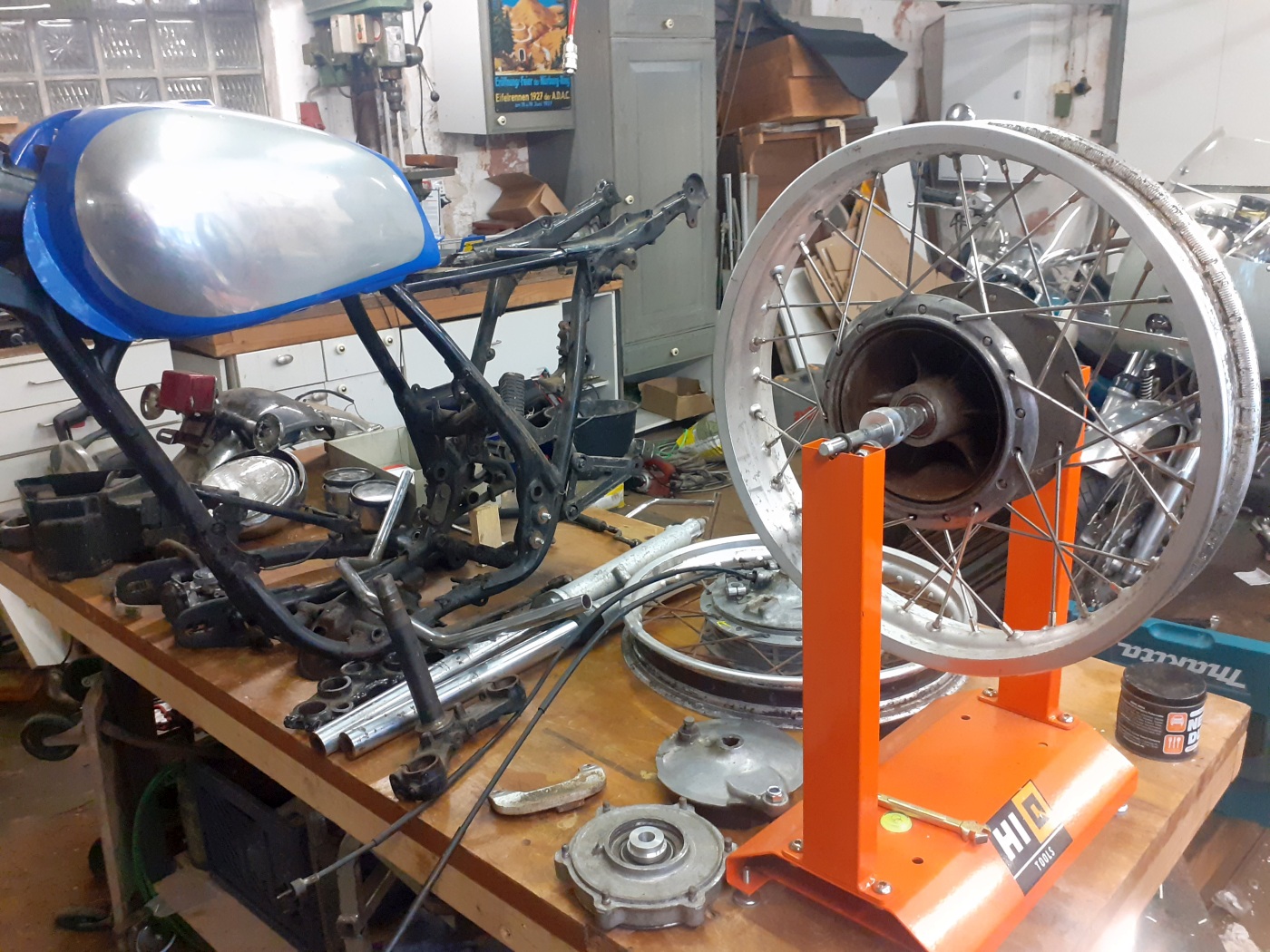
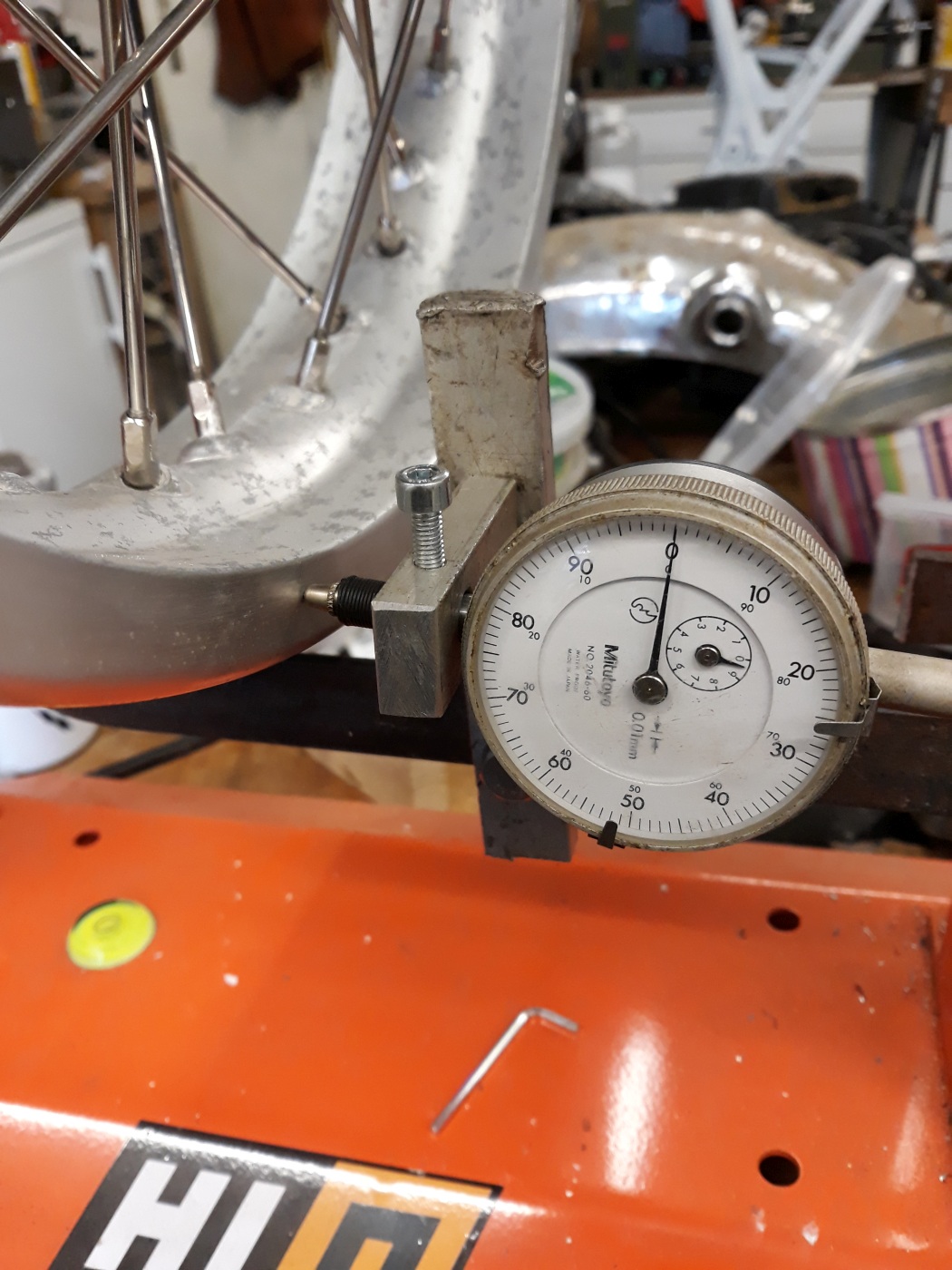
As we all know, the frame of the SR also stores the engine oil. A thorough inspection and cleaning was necessary here. Thorough flushing with petroleum or diesel dissolves the oil sludge. The strainer in the supply line connection must be cleaned. If you don't want to damage your freshly overhauled engine the first time you start it, you should be meticulous here.
Unfortunately, the fork stanchions of the SR500 rust quite quickly, but fortunately they are available from KEDO under 40330 along with the other wear parts. Fork oil seals: 21006, so nothing stands in the way of rebuilding the front end.
Martin also took care of the wheels himself. Not all that difficult. Stainless steel spoke sets for the SR500T: item 30609 for the beautiful front wheel with duplex drum, item 30501 for the rear wheel. After a few entertaining hours of polishing and centering, the sense of achievement is there. Of course, we also have the bearings and oil seals for the hubs. All new.
Thank you for allowing us to support and show your project. What is your motivation for restoring motorcycles?
Martin Terrey: Somehow I feel sorry for such neglected motorcycles. And I often see what could be done with them. And that the bikes belong back on the road to make someone happy. Although, strictly speaking, I don't restore motorcycles, I refurbish them and usually modify them according to my own ideas. At least when they are my own.
"I just have a big, oily heart."
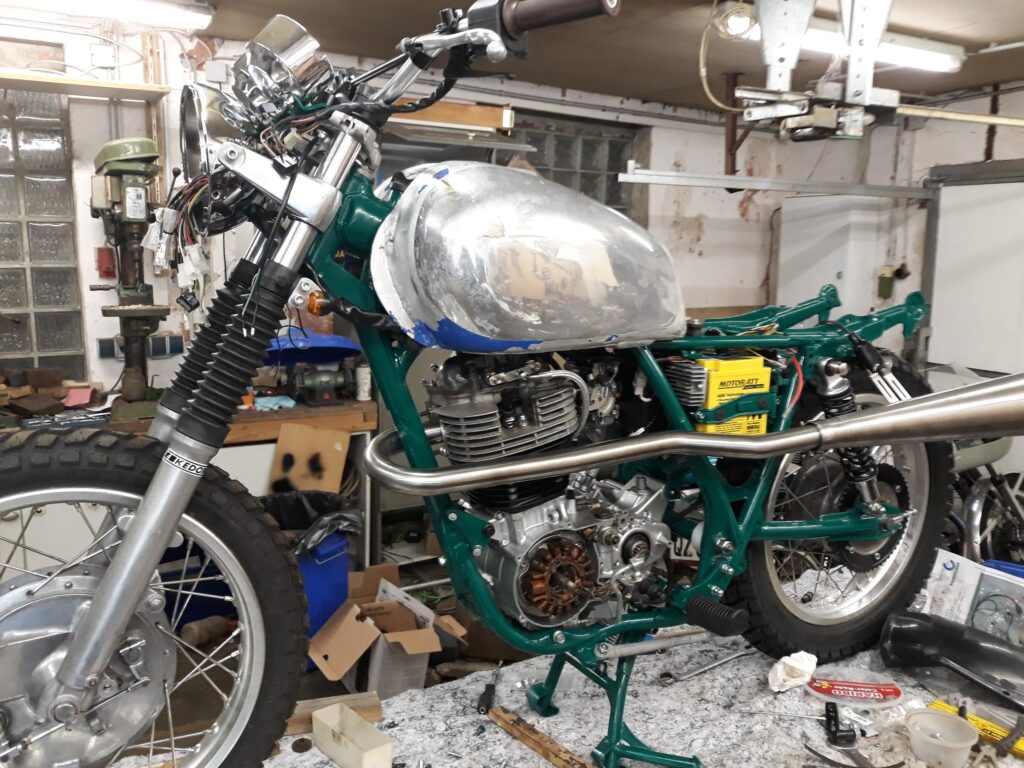
How did you come across Sleeping Beauty?
Martin: We met at work, so to speak. I maintain small biological wastewater treatment plants for a living. These are small wastewater treatment plants, mostly for individual households. And I get around all over the north, mostly north of the Kiel Canal. One customer in Dithmarschen, where I check the sewage pond every two years, had a Sleeping Beauty standing around in the garden alongside other motorcycles. And as it happens, "boy meets bike" etc., I asked him if he still needed the battered SR. I asked him regularly for about eight years. And then two years ago I had him ready. In the meantime, the ivy began to take possession of Sleeping Beauty.
The price: A little money plus two afternoons of help to change the engine on his Kawa Vulcan. I can do that. In return, he got Sleeping Beauty plus a second SR in parts and an additional engine. And various bits and pieces. You know these boxes. All in a slightly pitted condition from a damp, former stable. An SR with a frame from this collection has already been created. I call it the "Sternenkreuzer". The Sternenkreuzer is almost standard on the road - apart from the displacement, carburetor, camshaft and the double disc brake at the front.
The pictures were taken by Martin Terrey.
How did you come up with the idea of starting the project to support the hospice service?
Martin: I had already started building Sleeping Beauty beforehand and had begun to do so in the Caferacer Forum to post. The project runs under the title "Core scrap from Dithmarschen". I had already read about a number of campaigns in which motorcycles are assembled and auctioned off for a good cause. During a few vacation days on Römö last fall, I bought a copy of the "Custombike"in which a project for the Hamburg children's hospice "Sternbrücke" was described. A very beautiful, very professionally made bobber.
My Ulrike does voluntary outpatient end-of-life care with the Eiderstedt hospice service. And that's when the idea came up. The Sleeping Beauty became a Carity project relatively spontaneously
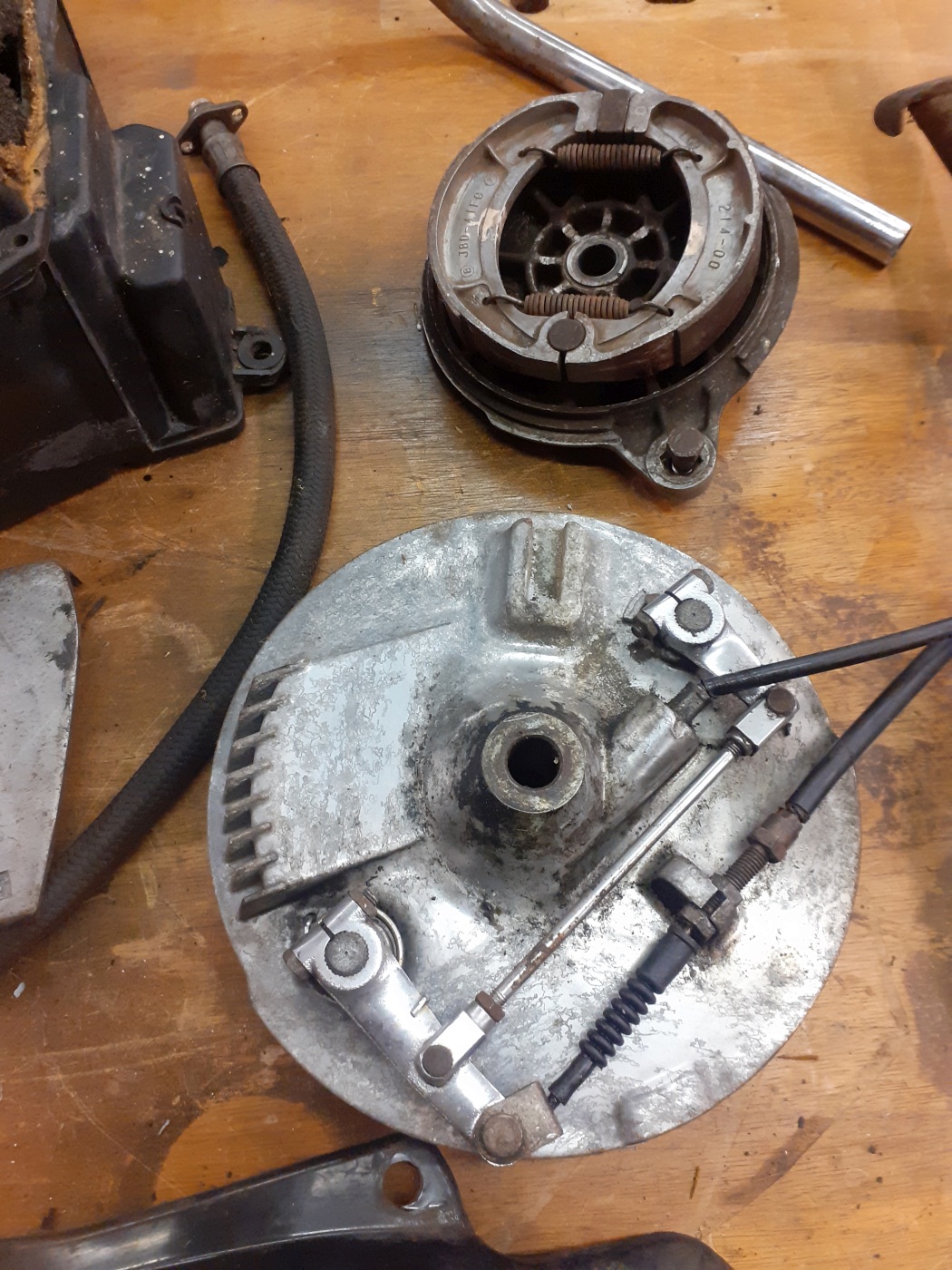
What appeals to you about the scrambler style you are aiming for?
Martin: Not very much at first, actually. My world is more the stub handlebars, even back then when I was still riding an XS 650 sidecar. Originally I thought to myself: The drum brake isn't that great, you've never bought enduro tires either - let's just do something completely different. If I think it's stupid, I'll put it on mobile.de.
Now, of course, it becomes something much better and is to be auctioned off.
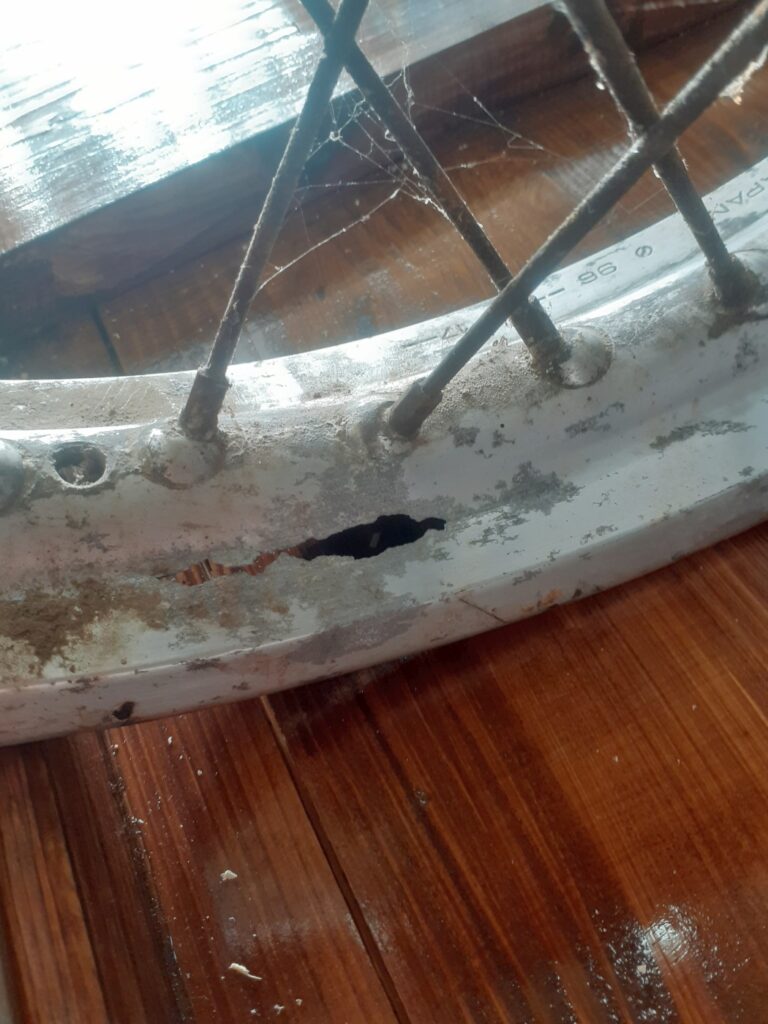
What was the biggest challenge in rescuing the SR500T?
Martin: There weren't really any major challenges. Of course, it was bitter to see what had been done to the bike and how the parts of the dismantled SR had suffered from storage. You have to get a rotten aluminum rim right first.
The alternator dismantled with an angle grinder was also a highlight. The spoking of the wheels was the most challenging part of the wrenching process. Because I've never done it before. And perhaps building the seat base plate. But with calm and care, you can actually do anything on the SR.
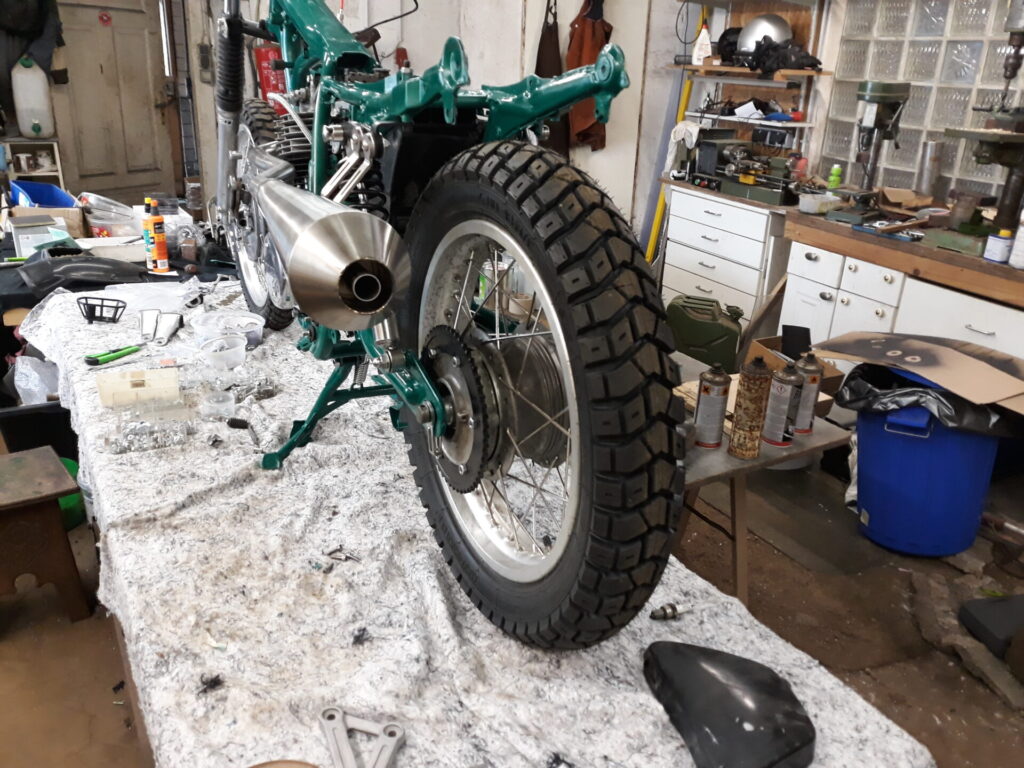
Who else contributed to the project?
Martin: When I wrote in the forum that the "half-troll" scrambler project was now being turned into something charitable, the first person immediately said: "Give me your account number". And after the first YouTube video was published, two of my customers also donated something. So we've already raised a few hundred. One donated a battery, another carburetor and mudguards, one contributed this great canister with camping equipment, one welded the engine housing, one covered the seat on the self-made base plate. And of course you, the KEDO company. This unsolicited help and attention from so many sides still leaves me speechless and humble. I would never have expected this in my life.
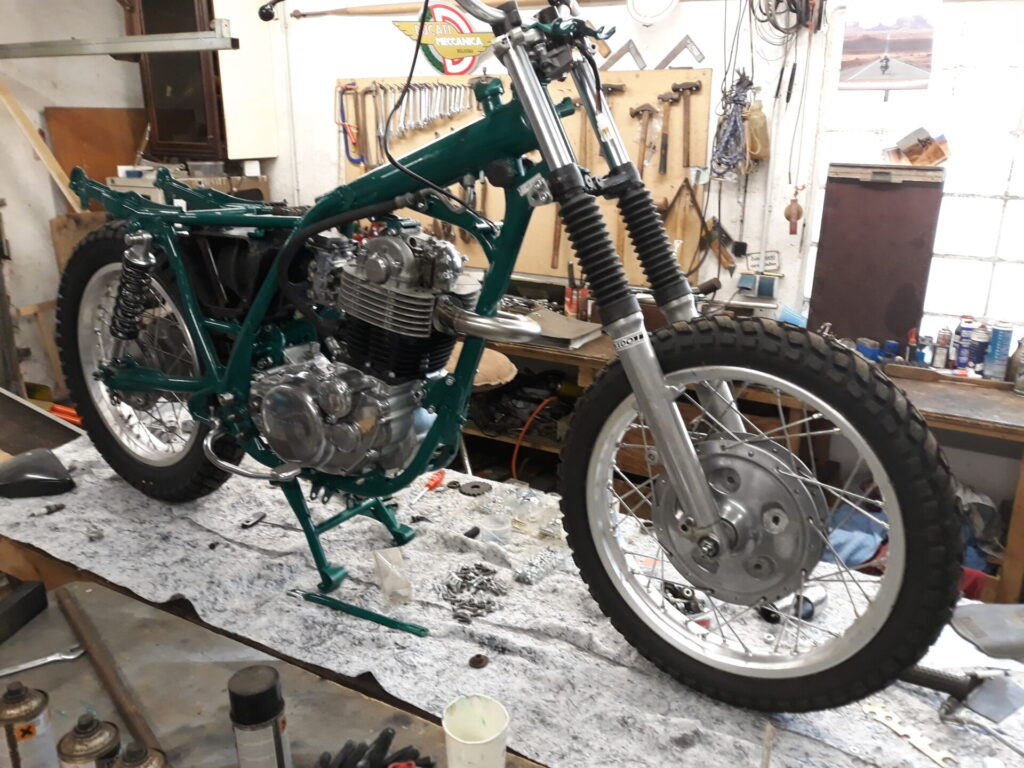
What is your next project?
Martin: The next step is to work through my stock of parts:
Possibly the body of a 2J4 in 79 series condition ... or again as a Caferacer...
I also still have the rolling chassis from my racetrack project, the Sushialdente. I could tackle that sometime. My TÜV inspector said that, depending on the age of the frame, I could get it approved. Let's see.
An XT500 frame is still floating around somewhere, as well as 1 ½ Honda CB 250 RS.
I don't have any really big dreams. I recently received my pension notification.
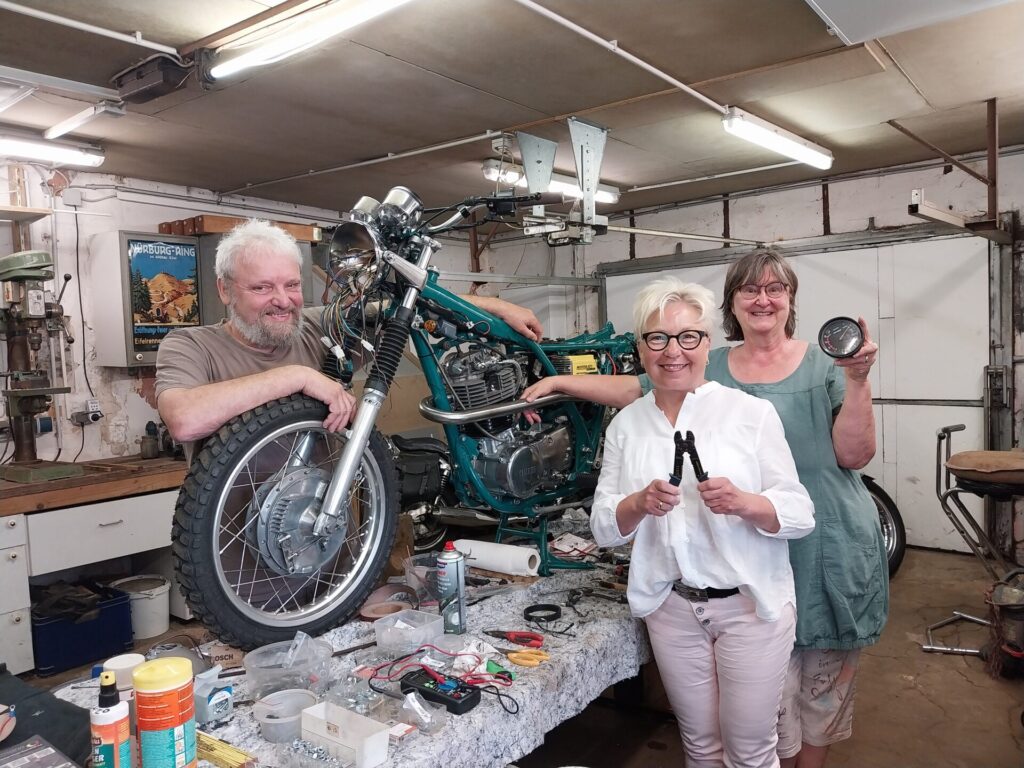
In the picture: Martin Terrey next to Dagmar Ströhle-Jensen and Ulrike Terrey from Hospizdienst Eiderstedt.
If you want to take as many steps as possible in the restoration process yourself, you shouldn't be afraid of dirt and new challenges.
In the end, everything should look great and work perfectly.
Once you have sorted through the supposed scrap and polished the good parts, your motivation is already extremely high.
What you need: A good manual, the right exploded views and the courage to ask for advice. And you're ready to go.
The parts are available in the KEDO webshop.
Thanks to the large number of SR500s sold, the supply of used parts is also assured. So three rusty SRs can become two Daily Rides again.
We think this is a good thing and support it with our work every day.
What work do you do yourself and where do you get help from others?
Martin: The boys from the Caferacer Forum were a huge help. I gratefully handed in the following work:
Cylinder drilling and honing.
Welding the engine housing - many thanks to Andreas from the forum.
The carburetor is a donation from Christian and was perfectly refurbished by Ralle.
The 3D print of the tank emblems came from Thilo. Philip sourced the seat bench from Austria.
Apart from that, I do everything myself.

How important is the screwdriver community to you?
Martin: The support from the forum with advice and criticism helps me a lot. I'm actually more of a loner and tinkerer. In the course of this project, I first had to learn to accept help. I don't have anyone in my own small circle of friends and acquaintances who tinkers.
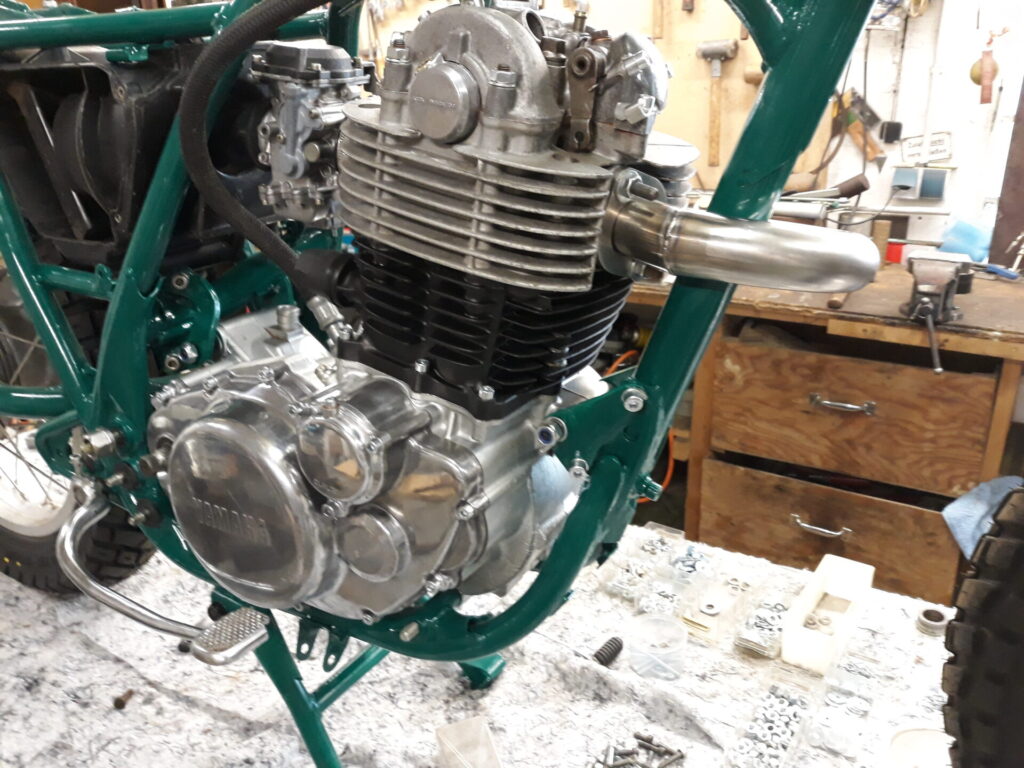
What has made the SR500 a cult motorcycle can also be seen at our friends from www.nippon-classic.de read more. The history of our favorite stew pot is very well recorded here.
Its simple design, versatility and timeless appearance have made the SR500 immortal. No engine has ever been so well documented. Every problem has been solved. Swarm knowledge as in the Bucheli projectis a huge help for all beginners and old hands alike.
The spare parts supply is really excellent compared to other youngtimers. Not least because of the good used parts market and of course: www.kedo.de
Our webshop is the No.1 source for every SR restoration. We are constantly on the hunt for the necessary spare parts, useful accessories and also offer in-depth service for carburetors, engines and chassis in our workshop. Questions? Problems? Give us a call, write to us at info@kedo.de
Take the plunge. Save one SR500 or XT500 and just drive off.
WHY ALL THIS?
If you're looking for inspiration on the subject of "just get going", we'd like to recommend some classics that turned some of us into compulsive motorcycle enthusiasts decades ago:
The documentary "On any Sunday" by Bruce Brown from 1971 and the book "Jupiter's Ride" by Ted Simon, who circumnavigated the globe on a motorcycle in the early seventies. Also and particularly inspiring: "Lone Rider: The First British Woman to Motorcycle Around the World" by British motorcycle traveler Elspeth Beard.
There is a lot of philosophy in life on a motorcycle.
